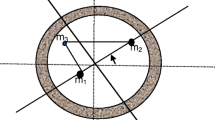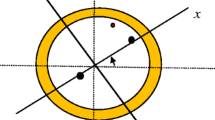Abstract
In this paper, the restricted problem of three bodies is generalized to include a case when the passively gravitating test particle is an oblate spheroid under effect of small perturbations in the Coriolis and centrifugal forces when the first primary is a source of radiation and the second one an oblate spheroid, coupled with the influence of the gravitational potential from the belt. The equilibrium points are found and it is seen that, in addition to the usual three collinear equilibrium points, there appear two new ones due to the potential from the belt and the mass ratio. Two triangular equilibrium points exist. These equilibria are affected by radiation of the first primary, small perturbation in the centrifugal force, oblateness of both the test particle and second primary and the effect arising from the mass of the belt. The linear stability of the equilibrium points is explored and the stability outcome of the collinear equilibrium points remains unstable. In the case of the triangular points, motion is stable with respect to some conditions which depend on the critical mass parameter; influenced by the small perturbations, radiating effect of the first primary, oblateness of the test body and second primary and the gravitational potential from the belt. The effects of each of the imposed free parameters are analyzed. The potential from the belt and small perturbation in the Coriolis force are stabilizing parameters while radiation, small perturbation in the centrifugal force and oblateness reduce the stable regions. The overall effect is that the region of stable motion increases under the combine action of these parameters. We have also found the frequencies of the long and short periodic motion around stable triangular points. Illustrative numerical exploration is rendered in the Sun–Jupiter and Sun–Earth systems where we show that in reality, for some values of the system parameters, the additional equilibrium points do not in general exist even when there is a belt to interact with.







Similar content being viewed by others
References
AbdulRaheem, A., Singh, J.: Astron. J. 131, 1880 (2006)
Abouelmagd, E.I., EL-Shaboury, S.M.: Astrophys. Space Sci. 341, 331 (2012)
Bhatnagar, K.B., Hallan, P.P.: Celest. Mech. 18, 105 (1978)
Chermnykh, S.V.: Leningradskii Univ. Vestnik Mat. Mekh. Astron., 73–77 (1987)
Douskos, C.N., Markellos, V.V.: Astron. Astrophys. 446, 357 (2006)
Greaves, J.S., Holland, W.S., Moriarty-Schieven, G., Jenness, T., Dent, W.R.F., Zuckerman, B., McCarthy, C., Webb, R.A., Butner, H.M., Gear, W.K., Walker, H.J.: Astrophys. J. 506, 133 (1998)
Jiang, I.G., Yeh, L.C.: Int. J. Bifurc. Chaos 14, 3153 (2004)
Jiang, I.G., Yeh, L.C.: Astrophys. Space Sci. 305, 341 (2006)
Kushvah, B.S.: Astrophys. Space Sci. 318, 41 (2008)
Miyamoto, M., Nagai, R.: Publ. Astron. Soc. Jpn. 27, 533 (1975)
Perdiou, A.E., Nikaki, A.A., Perdios, E.A.: Astrophys. Space Sci. 345, 57 (2013)
Radzievskii, V.V.: Astron. J. 27, 250 (1950)
Sharma, R.K.: Astrophys. Space Sci. 185, 271 (1987)
Singh, J., Ishwar, B.: Bull. Astron. Soc. India 27, 415 (1999)
Singh, J.: Astron. J. 137, 3286 (2009)
Singh, J.: Astrophys. Space Sci. 332, 331 (2011)
Singh, J., Leke, O.: Astrophys. Space Sci. 326, 305 (2010)
Singh, J., Leke, O., Umar, A.: Astrophys. Space Sci. 327, 299 (2010)
Singh, J., Leke, O.: Astrophys. Space Sci. 340, 27 (2012)
Singh, J., Leke, O.: Astrophys. Space Sci. 344, 51 (2013a)
Singh, J., Leke, O.: ISRN Astron. Astrophys. 2013, 910354 (2013b)
Singh, J., Umar, A.: Astron. J. 143, 109 (2012)
Singh, J., Taura, J.J.: Astrophys. Space Sci. 343, 95 (2013)
SubbaRao, P.V., Sharma, R.K.: Astron. Astrophys. 43, 381 (1975)
Szebehely, V.G.: Theory of Orbits. Academic Press, New York (1967)
Trilling, D.E., Stansberry’J, A., Stapelfeldt, K.R., Rieke, G.H., Su, K.Y.L., Gray, R.O., Corbally, C.J., Bryden, G., Chen, C.H., Boden, A., Beichman, C.A.: Astrophys. J. 658, 1289 (2007)
Wolfram, S.: The Mathematica Book, 5th edn. Wolfram, Media, Champaign (2003)
Author information
Authors and Affiliations
Corresponding author
Rights and permissions
About this article
Cite this article
Singh, J., Leke, O. Motion in a modified Chermnykh’s restricted three-body problem with oblateness. Astrophys Space Sci 350, 143–154 (2014). https://doi.org/10.1007/s10509-013-1733-6
Received:
Accepted:
Published:
Issue Date:
DOI: https://doi.org/10.1007/s10509-013-1733-6




